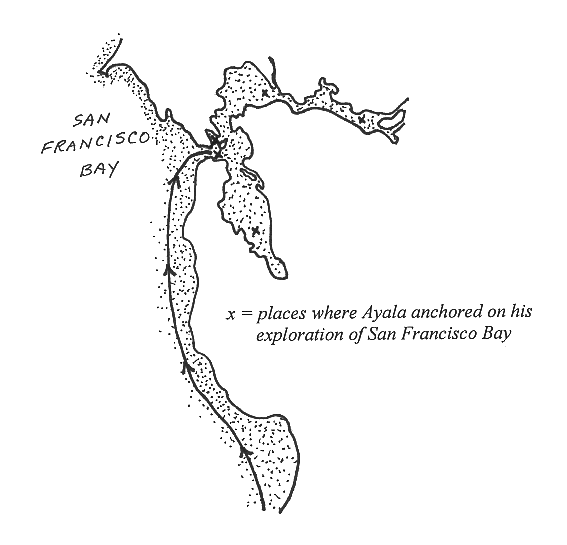| ||||
|
| ||||
|
JUAN
MANUEL DE AYALA
and San Francisco Bay
 Lived:
in the 1700s
Lived:
in the 1700s
Explored California in: 1775
Exploring for: Spain
Explored: by ship on San Francisco Bay
The fog that often covers the entrance to San Francisco Bay may have hidden it from those who explored the California coast in the 1500s and 1600s. Not until 1769 was there a report of the sighting of this huge bay. It was first explored by the Spanish in 1775.
EARLY HISTORY
Lt. Juan Manuel de Ayala was
a Spanish navigator sailing out of New Spain (
BACKGROUND
The first report about San Francisco
Bay came from Sgt. José Francisco Ortega (1734-98). Ortega, who had been born
in
When Portolás party was looking for Monterey Bay in 1769, they went north to what is now the San Francisco Peninsula. There, on November 1, Sgt. Ortega met some Indians who seemed to be telling him that there was a ship anchored to the north. When Ortega went to investigate, he saw a large, unknown body of water blocking his way. Ortega followed the shoreline far enough to see that the water stretched far to the north.
Portolá was not interested in the discovery. He wrote: “I did not linger there, nor did I see anything worthy of description there, save only a labyrinth of bays and channels which inundate the territory.” This was the shallow southern end of the bay. Father Crespí saw more possibilities. He wrote: “It is a very large and fine harbor, such that not only all the navy of our most Catholic Majesty but those of all Europe could take shelter in.”
Portolá left California in 1770 after establishing the Monterey presidio (fort). Lt. Fages, who was in charge there, did some exploring around San Francisco Bay in 1771-72. While scouting on the east side of the bay, he saw the Golden Gate entrance.
It was about this time that the name Bahia de San Francisco (Bay of San Francisco) began to be used. The explorers thought the new bay was an estuary of the smaller bay to the north (now called Drake’s Bay) which had been called San Francisco Bay by Sebastián Cermeño in 1595.
AYALA’S JOURNEY
Ayala was in
The mission of the San Carlos was to sail into San Francisco Bay. The other two ships were to continue north along the coast, searching for a Northwest Passage across the continent.
Ayala was to be the captain of the Sonora. Just before sailing, however, the captain of the San Carlos had a mental breakdown and Ayala took over as captain of that ship. The San Carlos carried a cargo of dried meat, garlic, red peppers, and live chickens and cows, and a crew of 23.
The San Carlos reached Monterey Bay near the end of June 1775. Planning his exploration into the great bay, Ayala had the ship’s carpenter make a canoe from a big redwood tree.
On August 4 the San Carlos was at the entrance to San Francisco Bay. The water was choppy and looked dangerous. Knowing that a small boat had more chance in choppy seas, Ayala sent a group of sailors in the canoe with instructions to row through the opening, into the bay. If the canoe got through, Ayala would follow with the ship.
In charge of this canoe was a young navigator named José Cañizares. He had been on the overland part of the Sacred Expedition from Baja (Lower) California to San Diego in 1769, and had remained in San Diego. Now he was serving as Ayala’s pilot.
Hours went by, and there was no sign of the canoe returning. About an hour before dark, Ayala decided to take the ship through the entrance anyway. He managed this safely, and anchored near the shore. In the morning, Cañizares and the crew of the canoe were there.
Ayala then found a good harbor for the San Carlos at an island in the bay where there was a supply of wood and water. Ayala exlored the bay for 40 days, making drawings and descriptions. He named Angel Island and Alcatraz Island (though the island he called Alcatraz is now Yerba Buena Island and the name Alcatraz was transferred to another island).
He had hoped to find a passage from the north end of San Francisco Bay out to Drake’s Bay, but none existed. He did find the mouth of the Sacramento River emptying into the bay at the north end. He described the salt marshes at the south end of the bay, and the groves of oak trees on the hills to the east of the bay.
Before leaving San Francisco Bay, Ayala put up a wooden cross near the bluff where they had anchored the first night. Beneath it he buried a message about their exploration. He then sailed the San Carlos out through the Golden Gate on September 17, 1775.
WHAT HE ACCOMPLISHED
Ayala was the first to sail a ship through the Golden Gate and into San Francisco Bay. He made the first charts of the bay, taking soundings to determine the depth of the bay at 485 places.
LATER YEARS
Ayala and the San Carlos
went back to Monterey, and then on to